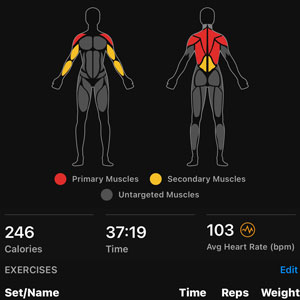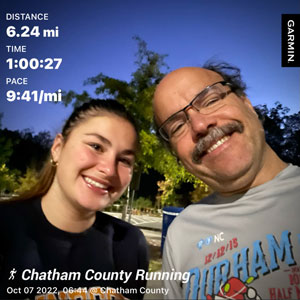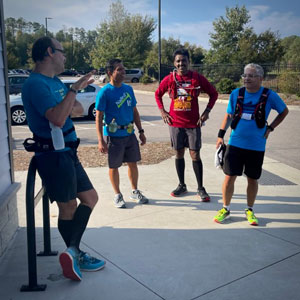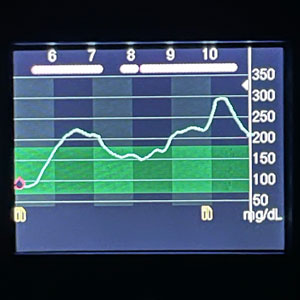Journey to a 100: Week 1/26 Assessment and Planning
This is part of a series of posts regarding how the InaseRunning group prepares, plans, and trains to complete the 100 miles Ultramarathon Umstead 100: Journey to a 100. For all the ultrarunning series and additional ideas, follow the link. Training for a 100.

You have decided to consider tackling an Ultra event. You might be a veteran, new to Ultra, or even recently started running. Don’t be afraid you are about to go on a self-learning journey, pushing the limits of what you thought you could do. To start and prepare for an ultramarathon, the planning and training can be fun and a very rewarding experience even if you do not sign up for an event by itself. My first “Ultra” was a self-imposed challenge to run my age in miles at age 44. (Un-official Ultra)
I have completed multiple Ultra-marathons distance events, including two 100-mile races. For this year, a few of the pacers and other friends will be tackling and training at the same time for the event. They say they are “just” doing the 50-mile option, but I know them; they are going to train really well and go for the whole enchilada. Our group comprises veteran marathoners and some ultramarathon runners that have completed 50k events. Our planning process will be very similar regarding how to prepare and map out that initial plan to tackle the event. There are two main areas of the process the first one is the assessment, in which you will have to be very honest with yourself about your current physical condition as a starting point, the training time available, and the reasons to tackle this distance. The second area is the end goal or target race. Once having those goals in mind, you can start coming back from that target event and work your way to the starting point.
Be aware that after you have this initial plan in place, it is only an initial guidance plan. There are other elements that you might want to add to the plan, like speed work, tempo runs, hill repeats, and many more in the initial parts of the plan. This barebone approach will probably serve you as an indicator of the reality of the current state and the reality of a plan.

You might decide that the plan might be too aggressive, and instead of doing the target event mileage, you might drop it one notch. Around week eight, you will need a sanity check as it is then that the time commitment and miles are going to take a serious turn. You might consider then switching from 100 miles to 100K or 50 miles or even a 50k. That is fine and ok too. Also, every week reaccess any adjustments to the plan, like doing a mini-retrospective. Although I will keep those changes within small increments or reductions. Unless you are faced with an injury or presented with big unexpected changes in your life that will require those big reductions. We will talk in a future post more about reviewing your initial goals (A, B, C, and so on) once you have a better understanding of your performance state and time.
Assessment:
The first thing I do when I am getting ready for an Ultra event, regardless of the distance, is to self-assess the starting point. There are a few questions I consider,
- What is my weekly mile base running? This will help me understand the starting running weekly load.
- What is the current base long run? I look for the past few weeks’ performances, whether there were events, training runs, or fun runs. The longest run on average. If I did a 50k (31 miles), but the rest has been 13 miles, my long run will sit closer to 13 rather than 31. On the other hand, if the other runs have been closing around 17-18 miles consistently, I will have my starting long run a tad closer to those 16 – 19 mile ranges.
- How is my back-to-back long-runs experience? Have I run a long run followed by at least a 10-mile or longer run the following day? How often? When was the last one?
- What is my work week’s daily mileage? Whether its 2 or 3 times during the work week, how many miles on average?
- With the current running load, how am I feeling? Can I complete workouts? Long runs? weekly distance? Am I tired? Do I feel fresh? Minimal soreness?
Using the answers from that list at a bare minimum will help me with an indication of whether or not I am ready to start training or do I need some adjustment, rest weeks, or minimal mileage to recover. But most importantly, answering what will be the starting point for this training season.
Planning:
Now, this is my process to prepare an initial plan, I know it is not going to be perfect, but it will serve as the basis for an initial approach to training,
- Determine your week – mine is Monday to Sunday. Others use Saturday to Sunday. Just make sure that for your reference the below is going to be Mon-Sun, five work day week and two day weekend for each week.
- Pick an event to tackle; for us, it will be the Umstead 100, in a calendar (electronic, pre-made, or blank paper), mark the day and race week (week 26), and start counting the weeks you have left. For us, at the time of publishing this, it is about 26 weeks.
- Two to Three weeks before the event will be your peak week.
- Weeks 22 & 23: Here, you are going to note your preferred peak week plan for the long runs. For me, for example, for our 100, I do back to back to back long runs (Fri 10, Sat 31, Sun 31)
- For the work week, an easy 3-6 miles run, no speed or hill workouts
- Weeks 24 and 25 are the taper week; we are cutting the mileage drastically to let the body recover and get in tip-top shape for the event.
- For week 2, the day after assessment and planning, use the information from the assessment to populate starting long runs and weekly mileage.
- From the starting week to week 23, start increasing the mileage of the longer (Back to back) runs gradually. I want to make steady progress, and it is possible to every two or so weeks of increasing, do a back-off mileage week to allow for better recovery.
This should serve as a reality check. Honesty with yourself is a must. If after this, you know this will push all your mental, physical, and will limits. As I mentioned earlier in the planning section, if your starting point is the couch or a 5k distance and you want to tackle 100 miles, you might have to reaccess the current short-term goal and length of the training plan. It is not that you can’t do it; it is that you will have to add longer time preparation. Safety and reducing the chance of injury are key, and even though it is not going to be easy, it should be doable. My base mile is decent and coming from a month of solid back-to-back runs and multiple events, followed by a 10+ mile back-to-back long run last month, giving me a great starting point.
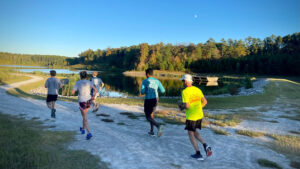
Below is a table with the initial plan and what it might look like:
| Week | Mon | Tue | Wed | Thu | Fri | Sat | Sun | Total |
|---|---|---|---|---|---|---|---|---|
| 1 | Rest/ Cross | 3 | 3 | 3 | Rest | 15 | 15 | 39 |
| 2 | Rest/ Cross | 3 | 3 | 3 | Rest | Rest | 15 | 21 |
| 3 | Rest/ Cross | 3 | 3 | 6 | Rest | 15 | 10 | 37 |
| 4 | Rest/ Cross | 3 | 3 | 6 | Rest | 15 | 15 | 42 |
| 5 | Rest/ Cross | 3 | 3 | 4 | Rest | 15 | 16 | 41 |
| 6 | Rest/ Cross | 5 | 3 | 6 | Rest | 15 | 15 | 42 |
| 7 | Rest/ Cross | 3 | 3 | 3 | Rest | 15 | 18 | 42 |
| 8 | Rest/ Cross | 3 | 6 | 3 | Rest | 18 | 13 | 43 |
| 9 | Rest/ Cross | 6 | 3 | 6 | Rest | 15 | 10 | 40 |
| 10 | Rest/ Cross | 6 | 3 | 3 | Rest | 15 | 11 | 38 |
| 11 | Rest/ Cross | 3 | 3 | 4 | Rest | 10 | 24 | 44 |
| 12 | Rest/ Cross | 6 | 3 | 6 | Rest | 16 | 16 | 47 |
| 13 | Rest/ Cross | 3 | 3 | 6 | Rest | 16 | 16 | 47 |
| 14 | Rest/ Cross | 4 | 3 | 6 | Rest | 15 | 26 | 54 |
| 15 | Rest/ Cross | 6 | 3 | Rest | 6 | 14 | 24 | 53 |
| 16 | Rest/ Cross | 6 | 3 | 4 | Rest | 16 | 26 | 55 |
| 17 | Rest/ Cross | 5 | 3 | Rest | 8 | 16 | 24 | 56 |
| 18 | Rest/ Cross | 6 | 6 | 6 | Rest | 20 | 26 | 64 |
| 19 | Rest/ Cross | 5 | 3 | Rest | 10 | 16 | 26 | 60 |
| 20 | Rest/ Cross | 6 | 3 | 5 | Rest | 16 | 26 | 56 |
| 21 | Rest/ Cross | 3 | 3 | Rest | 12 | 20 | 30 | 68 |
| 22 | Rest/ Cross | 6 | 3 | 6 | Rest | 24 | 20 | 59 |
| 23 | Rest/ Cross | 3 | Rest | Rest | 10 | 31 | 31 | 75 |
| 24 | Rest/ Cross | 3 | 3 | 3 | Rest | 15 | 10 | 35 |
| 25 | Rest/ Cross | 3 | 3 | 6 | Rest | 6 | 13 | 31 |
| 26 | Rest | 5 | 3 | Rest | Rest | Race | 100 | 108 |
Blue – Headlamp ready runs
Race – Push the pace
Rest – Basically, no running; walks are ok
Grey – Build Block Weeks: increase endurance
Pink – Ultra-Prep Block Weeks: practice event simulation
Orange – Taper Block Weeks: Focus on recovery, sleep, and mental freshness

How is the plan going:
Summary: It has been a great week to start training. After a few adjustments and shifting to gain some energy, it felt solid. Temperatures are helping as this week stayed very cool in the morning.
Monday: Visit the gym in the early morning, trying to figure things out a little bit
Tuesday: Early fresh morning, ten solid miles
Wednesday: Feeling tired this morning, normally I do double-day runs on Wednesdays but this morning decided to sleep in a bit and do the run in the afternoon with the InsaneRunners group. Venu joined us during this week’s run, he was making his recovery run after an excellent performance over the weekend of back-to-back Full Marathons.
Thursday: I decided to skip this morning as I felt really tired and not well recovered.
Friday: My daughter arrived for fall break yesterday and wants to go for a run in the morning. How can I refuse such an invitation? I had a blast early morning run with her.
Saturday: Solid 15-mile run with the group this morning. Jamie already had 5 when he joined us in the morning as he is preparing for NY Marathon in November. Sugars were bouncing a little bit but never on the low range.
Sunday: Excellent cooler weather today. Headed out early for a solo run this time. It took about 5 miles for my body to warm up and loosen up. I got to the water fountain around the 6-mile post to find out it was not operational due to repairs in the area. I carried a water bottle with fuel and did not need the water, but it would have been nice to refill the bottle I was heading back to.
This week’s actual numbers:
| Week 1 | Mon | Tue | Wed | Thur | Fri | Sat | Sun | Total |
| Plan | Stretches & Rolling | 3 | 3 | 3 | Stretches & Rolling | 15 | 15 | 39 |
| Actual | Gym | 10 | 6 | 0 | 6 | 15 | 15 | 52 |
Next Week Plan: Notable item – Event on Sunday
| Week 2 | Mon | Tue | Wed | Thur | Fri | Sat | Sun | Total |
| Plan | Stretches & Rolling | 3 | 3 | 3 | Stretches & Rolling | Rest | 15 | 21 |
